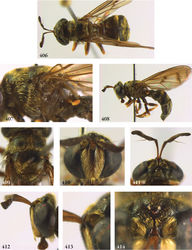Thompsodon conspicillifrons
| Notice: | This page is derived from the original publication listed below, whose author(s) should always be credited. Further contributors may edit and improve the content of this page and, consequently, need to be credited as well (see page history). Any assessment of factual correctness requires a careful review of the original article as well as of subsequent contributions.
If you are uncertain whether your planned contribution is correct or not, we suggest that you use the associated discussion page instead of editing the page directly. This page should be cited as follows (rationale):
Citation formats to copy and paste
BibTeX: @article{Reemer2013ZooKeys288, RIS/ Endnote: TY - JOUR Wikipedia/ Citizendium: <ref name="Reemer2013ZooKeys288">{{Citation See also the citation download page at the journal. |
Ordo: Diptera
Familia: Syrphidae
Genus: Thompsodon
Name
Thompsodon conspicillifrons Reemer sp. n. – Wikispecies link – ZooBank link – Pensoft Profile
- Microdon MCR-12 Thompson, in litt.
Type specimens
HOLOTYPE. Female. Label 1: “COSTA RICA, Prov. Limón, / A.C.L.A.C., Talamanca, San Miguel, / Albergue, CASACODE, Send Cerillos. / 10-30 m. 23-26 FEB 1999. M. Lobo. / L_S_391000_612000 #52454”; label 2: “MCR-12”; label 3 (barcode): “INB0003024775 / INBIOCRI COSTA RICA”. Coll. INBIO.
Diagnosis
See generic key and genus account of Thompsodon (only one species known).
Description (based on holotype)
Adult male. Body size: 8 mm.
Head. Face occupying about 1/3 of head width in frontal view; yellow with black median vitta, which is dorsally about as wide as the antennal fossa and gradually narrows downward, becoming absent in ventral 1/4; yellow pilose, except for sparse black pile submedially, narrowly bare medially. Gena blackish; yellow pilose. Lateral oral margins not produced. Frons black; golden pilose; laterally with round, concave areas, filled with dense golden pile, ventrally delimited by a sharply defined ridge. Vertex irregularly swollen; black; short golden pilose. Ocellar triangle not elevated. Occiput narrow ventrally, strongly widened dorsally; black; golden pilose. Eye bare. Antennal fossa about as high as wide. Antenna with scape pale brown, pedicel and basoflagellomere blackish brown; antennal ratio approximately as 4:1:4.
Thorax. Mesoscutum black; golden pilose, except for pair of black pilose patches anteriad of transverse suture and wide fascia of black pile posteriad of transverse suture. Postpronotum and postalar callus brown, golden pilose. Scutellum black; golden pilose. Pleuron yellowish brown, except anepisternum and anepimerond blackish. Anepisternum with deep sulcus separating posterior from anterior part; entirely mixed yellow and black pilose. Anepimeron entirely mixed yellow and black pilose. Katepisternum long yellow pilose dorsally, bare ventrally. Katatergum short microtrichose, anatergum bare. Calypter dark greyish. Halter yellow.
Wing: hyaline, slightly brownish, especially anteriorly; microtrichose, except bare on cell bc, posterobasal 1/6 of cell c, basal 1/6 of cell r1, entirely on cell br except microtrichose on vena spuria, basal 1/2 of cell bm, and basal 1/2 of cell cup.
Legs: Femora blackish brown, except yellow apically; black pilose. Tibiae and tarsi yellow. Tibiae yellow pilose, except black pilose apically. Tarsi black pilose. Coxae and trochanters blackish brown; black pilose.
Abdomen. More or less oval, but tergite 1 very narrow, so appears constricted basally. Tergites 3 and 4 not fused, able to articulate independently. Tergites blackish. Tergite 1 yellow pilose. Tergite 2 short black pilose, with medially interrupted fascia of longer golden pile along posterior margin. Tergite 3 with similar pattern of pile as tergite 2, but fascia of golden pile medially strongly extended over median part of tergite. Tergite 4 largely golden pilose, except for narrow median vitta of black pile and sublateral oblique vittae of black pile. Tergite 5 golden pilose. Sternites black. Sternite 1 bare, other sternites golden pilose.
Male. Unknown.
Etymology
The specific epithet (noun in apposition) is composed of the Latin words conspicillum (spectacles) and frons (forehead). The name refers to the concave lateral areas on the frons which (in the eyes of susceptible beholders) evoke the impression of glasses on a forehead.
Notes
This species was first recognized as an undescribed taxon by F.C. Thompson, who gave it the preliminary code-name Microdon MCR-12.
Original Description
- Reemer, M; Ståhls, G; 2013: Generic revision and species classification of the Microdontinae (Diptera, Syrphidae) ZooKeys, 288: 1-213. doi
Images
|

